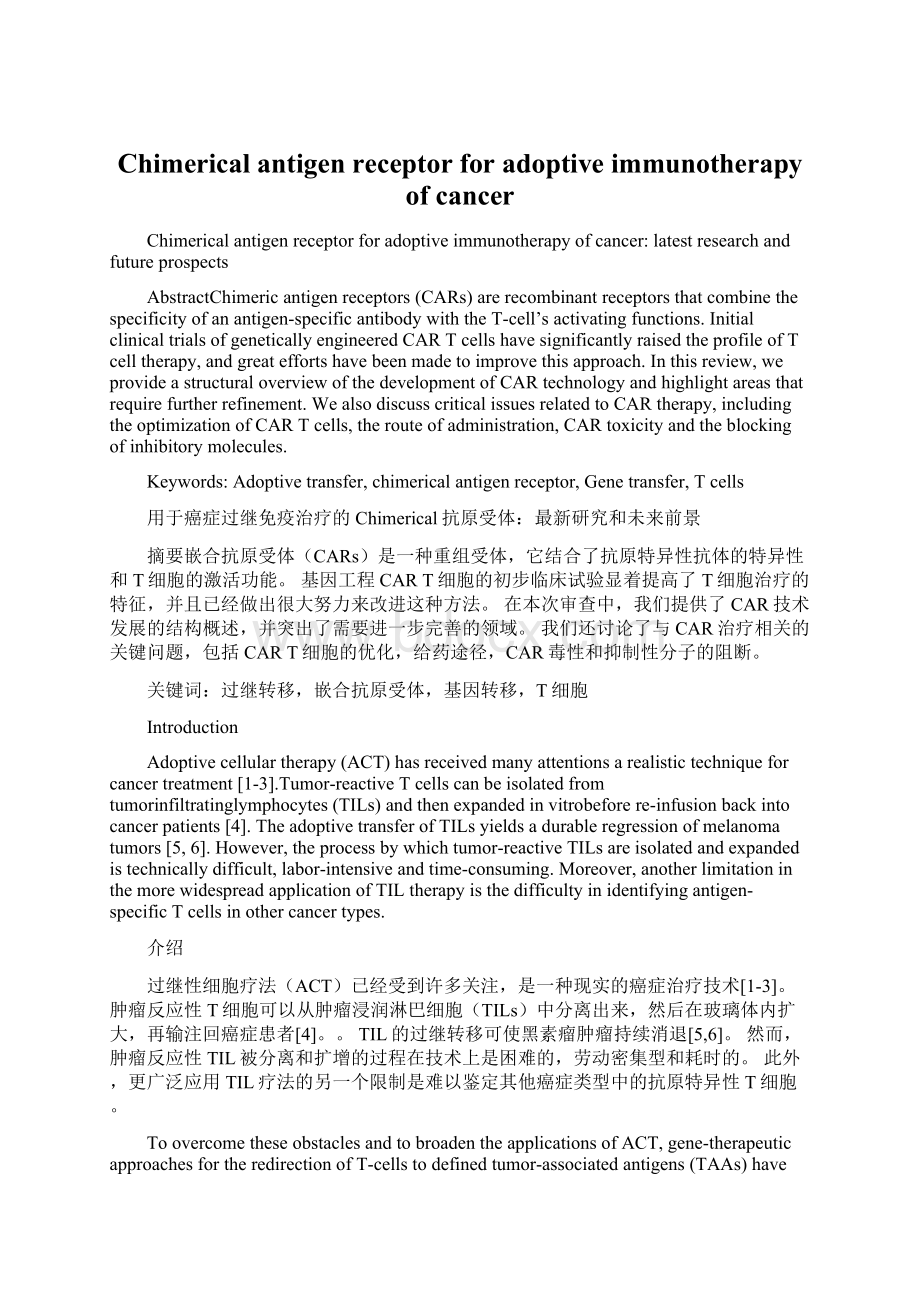Chimerical antigen receptor for adoptive immunotherapy of cancer.docx
《Chimerical antigen receptor for adoptive immunotherapy of cancer.docx》由会员分享,可在线阅读,更多相关《Chimerical antigen receptor for adoptive immunotherapy of cancer.docx(12页珍藏版)》请在冰豆网上搜索。

Chimericalantigenreceptorforadoptiveimmunotherapyofcancer
Chimericalantigenreceptorforadoptiveimmunotherapyofcancer:
latestresearchandfutureprospects
AbstractChimericantigenreceptors(CARs)arerecombinantreceptorsthatcombinethespecificityofanantigen-specificantibodywiththeT-cell’sactivatingfunctions.InitialclinicaltrialsofgeneticallyengineeredCARTcellshavesignificantlyraisedtheprofileofTcelltherapy,andgreateffortshavebeenmadetoimprovethisapproach.Inthisreview,weprovideastructuraloverviewofthedevelopmentofCARtechnologyandhighlightareasthatrequirefurtherrefinement.WealsodiscusscriticalissuesrelatedtoCARtherapy,includingtheoptimizationofCARTcells,therouteofadministration,CARtoxicityandtheblockingofinhibitorymolecules.
Keywords:
Adoptivetransfer,chimericalantigenreceptor,Genetransfer,Tcells
用于癌症过继免疫治疗的Chimerical抗原受体:
最新研究和未来前景
摘要嵌合抗原受体(CARs)是一种重组受体,它结合了抗原特异性抗体的特异性和T细胞的激活功能。
基因工程CART细胞的初步临床试验显着提高了T细胞治疗的特征,并且已经做出很大努力来改进这种方法。
在本次审查中,我们提供了CAR技术发展的结构概述,并突出了需要进一步完善的领域。
我们还讨论了与CAR治疗相关的关键问题,包括CART细胞的优化,给药途径,CAR毒性和抑制性分子的阻断。
关键词:
过继转移,嵌合抗原受体,基因转移,T细胞
Introduction
Adoptivecellulartherapy(ACT)hasreceivedmanyattentionsarealistictechniqueforcancertreatment[1-3].Tumor-reactiveTcellscanbeisolatedfromtumorinfiltratinglymphocytes(TILs)andthenexpandedinvitrobeforere-infusionbackintocancerpatients[4].TheadoptivetransferofTILsyieldsadurableregressionofmelanomatumors[5,6].However,theprocessbywhichtumor-reactiveTILsareisolatedandexpandedistechnicallydifficult,labor-intensiveandtime-consuming.Moreover,anotherlimitationinthemorewidespreadapplicationofTILtherapyisthedifficultyinidentifyingantigen-specificTcellsinothercancertypes.
介绍
过继性细胞疗法(ACT)已经受到许多关注,是一种现实的癌症治疗技术[1-3]。
肿瘤反应性T细胞可以从肿瘤浸润淋巴细胞(TILs)中分离出来,然后在玻璃体内扩大,再输注回癌症患者[4]。
。
TIL的过继转移可使黑素瘤肿瘤持续消退[5,6]。
然而,肿瘤反应性TIL被分离和扩增的过程在技术上是困难的,劳动密集型和耗时的。
此外,更广泛应用TIL疗法的另一个限制是难以鉴定其他癌症类型中的抗原特异性T细胞。
ToovercometheseobstaclesandtobroadentheapplicationsofACT,gene-therapeuticapproachesfortheredirectionofT-cellstodefinedtumor-associatedantigens(TAAs)havebeendeveloped[7].OnesophisticatedstrategyinvolvestheengineeringofantilogousT-cellswithachimericalantigenreceptor(CAR)[8],whichiscomposedofaspecificantigen-bindingmoietythatisderivedfromthevariableregionsofamonoclonalantibody(mAb)andlinkedthroughahingeandatransmembrane(TM)motiftoacytoplasmlymphocyte-signalingmoiety[9,10].TheCARsendowTellsantigen-specificrecognition,activationandproliferationinanMHC-independentmanner.CurrentclinicaltrialsusingengineeredCARTcelltherapydemonstrateclinicalresponsesinbothhematologicalmalignanciesandsolidtumors[2,11].Here,wewillprovideanoverviewoftherecentdevelopmentoftheCARtechnologyanddiscussthechallengesandfutureprospectsforthispioneeringapproach.
为了克服这些障碍并拓宽ACT的应用,已经开发出用于将T细胞重定向至确定的肿瘤相关抗原(TAA)的基因治疗方法[7]。
一种复杂的策略涉及利用嵌合抗原受体(CAR)[8]设计自体T细胞,该细胞由特异性抗原结合部分组成,该部分来源于单克隆抗体(mAb)的可变区并通过铰链和跨膜(TM)基序到细胞质淋巴细胞-信号传导部分[9,10]。
CARs以不依赖于MHC的方式赋予Tcells抗原特异性识别,激活和增殖。
使用工程化CART细胞疗法的当前临床试验证明了血液恶性肿瘤和实体瘤的临床反应[2,11]。
在这里,我们将概述CAR技术的最新发展,并讨论这种开创性方法的挑战和未来前景。
CARbindingdomain
TheclassicCARconsistsofanextracellularantigenrecognitiondomainattachedtoanextracellularspacer/hingedomain,aTMregionthatanchorsthereceptortithecellsurfaceandasignalingenddomain.Ascoffderivedfromthevariableheavychain(VH)andvariablelightchain(VL)regionsofanantigen-specificmoblinkedbyflexiblelinkeriscommonlyutilizedastheextracellularTAA-bindingdomaininmostCARs(Figure1A).ThescFvretainsthesamespecificityandasimilaraffinityasthefullantibodyfromwhichitwasderived[12].Moreover,thesmallmolecularsizeofscoffsfacilitatesboththegeneticmanipulationandexpressionoftheCAR.Furthermore,itdeterminestheCARantigenspecificityandbindsthetargetproteininanMHC-independentmanner.Todate,thescoffsofCARsaremostoftenderivedfrommousemAbs.Humananti-mouseantibody(HAMA)responsescanoccurwithindaysandcanblockantigenrecognitionbyCARs.Therefore,theuseofhumanized[13]orfullyhumanscoff[14]maybepreferabletomousescoff.Inaddition,theaffinityofscoffmustbeconsideredinthedesignofCARs.TheaffinityofthescoffselectedfordesigningCARalsoshouldbeconsidered.Hudeceketal.[15]showedthatincreasingtheaffinityofaCARenhancesits-celleffectorsfunctionandrecognitionoftumors.However,thedevelopmentofhigheraffinityCARswithgreateranti-tumoractivitycouldtheoreticallyincreasetheriskofon-targettoxicityandmandatescarefulsafetystudiesinrelevantmodel.
CAR结合域
经典CAR由附着于细胞外间隔区/铰链结构域的细胞外抗原识别结构域,将受体锚定至细胞表面的TM区和信号传导内结构域组成。
衍生自通过柔性接头连接的抗原特异性mAb的可变重链(VH)和可变轻链(VL)区的scFv通常用作大多数CAR中的细胞外TAA结合结构域(图1A)。
scFv保留了与其衍生的完整抗体相同的特异性和相似的亲和力[12]。
此外,scFv的小分子大小有利于CAR的遗传操作和表达。
此外,它确定CAR抗原特异性并以不依赖MHC的方式结合靶蛋白。
迄今为止,CAR的scFv通常源自小鼠mAb。
人抗小鼠抗体(HAMA)反应可在数天内发生,并可阻断CAR的抗原识别。
因此,使用人源化[13]或完全人scFv[14]可能优于小鼠scFv。
此外,在CAR的设计中必须考虑scFv的亲和力。
还应考虑选择用于设计CAR的scFv的亲和力。
Hudecek等人。
[15]表明,增加CAR的亲和力可增强其T细胞效应功能和肿瘤识别。
然而,具有更高抗肿瘤活性的更高亲和力的CAR的发展理论上可以增加中心靶毒性的风险并且需要在相关模型中进行仔细的安全性研究。
Theextracellularantigen-recognitiondomainofCarscanalsobealegendforareceptorthatisexpressedontumorcells[11].Nonscoff-basedlegend-bindingdomainshavebeenutilizedinaCARformat(Figure1B).Forexample,theCD27receptor[16],theheregulinmolecule(alignedforHer3andHer4receptors)[17],interleukin(IL)-13mutein[18],vascularendothelialgrowthfactor(anti-VEGFR2)[19],andtheNKG2Dreceptor[20-22],havebeenusedsuccessfullyforengineeredT-celltherapy,resultingintumorregressioninvivo.Recently,anovelchimericNKp30CARtargetingtheB7-H6(NKp30legend)expressingtumorwasdeveloped[23].
CAR的细胞外抗原识别结构域也可以是在肿瘤细胞上表达的受体的配体[11]。
基于非scFv的配体结合结构域已经以CAR形式使用(图1B)。
例如,CD27受体[16],调蛋白分子(Her3和Her4受体的配体)[17],白细胞介素(IL)-13突变蛋白[18],血管内皮生长因子(抗VEGFR2)[19],和NKG2D受体[20-22]已成功用于工程化T细胞治疗,导致体内肿瘤消退。
最近,开发了一种靶向B7-H6(NKp30配体)表达肿瘤的新型嵌合NKp30CAR[23]。
ToexpandtheapplicationsforTcell-basedimmunotherapyincancer,Tamaraetal.[24]andUrbanskaetal.[25]constructedsimilar“universal”CARs(car)thatutilizeanti-fluoresceinisothiocyanate(FITC)scoffandavidinineitheramonomer(mica)ordiametric(dace)formasbindingdomainsfusedtoT-cellsignalingdomains,respectively(Figure1C).ThesecarTcellsrecognizevariouscancertypeswhenboundtoFITClabeledorbiotinylatedantigen-specificmobsorscFvs,resultinginefficienttargetlyses,T-cellproliferation,andcytokineproduction.Morerecently,Kudosetal.[26]constructednoveluCARcontainingthehigh-affinityCD16(FCGR3A)V158variant,CD8αhingeandtransmembranedomains,alongwithsignalingdomains.CD16V-baseduCARTcellshaveboundhumanizedantibodieswithhigheraffinityandengagementoftheCD16V-uCARprovokedTcellactivation,exocytosisofthelyticgranulesandsustainedproliferation.Further,theco-administrationofCD16VuCARTcellswithimmunotherapeuticantibodiesexertedconsiderableantitumoractivityinvivo.Importantly,thetreatmentofimmunocompromisedmiceusingthenoveluCARTcellsplusthelabeledmAbscurrentlyinclinicaluseexhibitedpotentantitumoractivity.TheneedformanydifferentimmunereceptorgenestocoverallcancerslimitsthefeasibilityofACT,andtheuseofuCARsmayaddressthisissue.
为扩大癌症中基于T细胞的免疫疗法的应用,Tamada等。
[24]和Urbanska等人[25]构建了类似的“通用”CARs(uCAR),其利用异硫氰酸荧光素(FITC)scFv和抗生物素蛋白以单体(mcAv)或二聚体(dcAv)形式作为分别与T细胞信号传导结构域融合的结合域(图1C)。
当与FITC标记的或生物素化的抗原特异性mAb或scFv结合时,这些uCART细胞识别各种癌症类型,导致有效的靶裂解,T细胞增殖和细胞因子产生。
最近,Kudo等人。
[26]构建了一种新的uCAR,其含有高亲和力CD16(FCGR3A)V158变体,CD8α铰链和跨膜结构域,以及信号结构域。
基于CD16V的uCART细胞结合了具有更高亲和力的人源化抗体,并且CD16V-uCAR的参与激发了T细胞活化,裂解颗粒的胞吐作用和持续增殖。
此外,CD16VuCART细胞与免疫治疗性抗体的共同施用在体内发挥了相当大的抗肿瘤活性。
重要的是,使用新型uCART细胞加上目前临床使用的标记mAb治疗免疫受损小鼠表现出有效的抗肿瘤活性。
需要许多不同的免疫受体基因来覆盖所有癌症限制了ACT的可行性,并且使用uCAR可以解决这个问题。
CARtargeting
MostantigenstargetedbyCAR-Tcellsaresimply‘tumorassociated’andnot‘tumor-specific’.Thepotentialfor“on-target,off-organ”toxicityisaseriousconcerninCART-celltherapy.Thus,thejudiciousselectionofTAAsisthefirststepandiscriticaltothesuccessofCAR-basedACT.CD19isthewidelyandsuccessfullyutilizedtargetofCAR-modifiedTcells[27-29],beinguniversallyexpressedbyacutelymphoblasticleukemia,themostcommonmalignancyofchildren,whereasitsexpressiononnon-tumortissuesisrestrictedtoB-cellsandtheirprogenitors,butnothematopoieticstemcells.Thetoxicityoftargetingthisantigenusinganti-CD19CAR-modifiedTcellsislimitedtoBcellaplasiaandtheconsequenteffectsonhumoralimmunity,whichisconsideredtobeatolerableside-effectofthistherapy[11].Incontrast,onecoloncancerpatienttreatedwithHer2/neuCAR-Tcellsdied5daysaftertheadoptivetransfer;thispatientdiedofwhatappearstohavebeenacytokinestormandrespiratoryfailuretriggeredbytherecognitionofthelowlevelsofantigensonlungepithelialcells[30].ThesestudiessuggestthatidealTAAsarerequiredbythetumorcellforsurvivalandshouldshowrestrictedexpressiontothetumorcellsurfaceandotherwisenon-vitaltissues.
CAR定位
CAR-T细胞靶向的大多数抗原只是“肿瘤相关”而不是“肿瘤特异性”。
“靶向,非器官”毒性的可能性是CART细胞疗法中的严重问题。
因此,明智地选择TAA是第一步,对CAR-BASEDACT的成功至关重要。
CD19是广泛且成功利用的CAR修饰T细胞[27-29]的目标,由急性淋巴细胞白血病(儿童最常见的恶性肿瘤)普遍表达,而其在非肿瘤组织中的表达仅限于B细胞及其祖细胞,但不是造血干细胞。
使用抗CD19CAR修饰的T细胞靶向该抗原的毒性仅限于B细胞发育不良及其对体液免疫的影响,这被认为是该疗法的可耐受的副作用[11]。
相反,用Her2/neuCAR-T细胞治疗的一名结肠癌患者在转移转移后5天死亡;这名患者因肺上皮细胞中低水平抗原识别引起的细胞因子风暴和呼吸衰竭而死亡[30]。
这些研究表明,理想的TAA是肿瘤细胞存活所必需的,并且应该显示出对肿瘤细胞表面和其他重要组织的限制性表达。
TheeffectofantigendensityforCARtherapyisnotyetwelldefined.ItappearsthatCARTcellstypicallytargethighlyexpressedantigens,whilelowantigenexpr